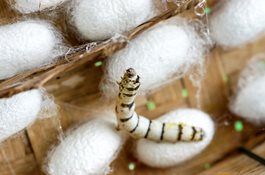
“Above there is heaven. Below there is Hangzhou” runs a popular Chinese proverb, and it is easy to see why.
The beautiful city of Hangzhou, one of China’s seven ancient capitals is renowned for its stunning lakefront scenery and its world-famous Xi Lu Long Jing tea, but it is silk that put Hangzhou on the map more than 5,000 years ago and it is silk which keeps this cultural capital firmly on the map today.
Chinese legend recounts how the beautiful Empress Leizu, wife of the renowned Yellow Emperor, discovered silk by accident in the 4th millennium BCE. The fourteen-year old empress was enjoying a cup of tea in the shade of a mulberry tree when a caterpillar cocoon fell into her cup from the tree. The empress watched fascinated as the cocoon expanded in the hot water, and the fine strands of durable thread slowly unwound themselves. Leizu coiled the thread around her finger, finding to her astonishment that it stretched a considerable distance. She took the thread to her loom and the rest is an essential part of Chinese history. Leizu became the first Chinese woman to practice sericulture, or silk manufacturing, and in popular culture she is still revered as the Silk Goddess.
The cocoons woven by the larva of the
Bombyx mori or mulberry silkworms give Chinese silk the smooth nap and shiny color which made it a highly-prized commodity across the ancient world. The Chinese emperors jealously guarded their monopoly on silk manufacture, reserving the elite fabric for their own exclusive use and declaring the export of silkworms a crime punishable by death. But by the 1st millennium BCE, demand for the fabric gave rise to its lucrative trade along the famous Silk Road. By this time, the uses of silk went beyond imperial ceremonial garments and it was increasingly used in practical applications such as fishing nets, paper manufacture, and the decorative arts.
By 522 CEE, the Byzantines had got hold of silkworm eggs and were beginning to manufacture their own fabric, but Chinese silk remains a highly-prized luxury. In modern-day Hangzhou, enjoy a visit the largest silk museum in the world to learn more about the fascinating history of sericulture, as well as prime shopping opportunities in the almost 800 shops in Silk City, a pedestrian mall lined with merchants selling all manner of silken goods.
Alexander + Roberts offer a range of opportunities to explore Hangzhou’s rich history and heritage, such as popular escorted
China Sampler or add
Hangzhou to any of our diverse China itineraries.